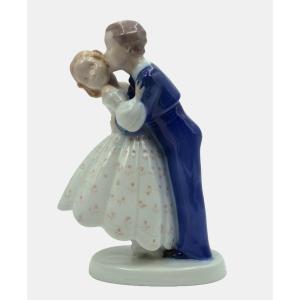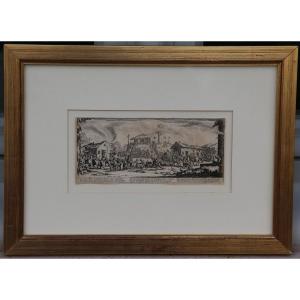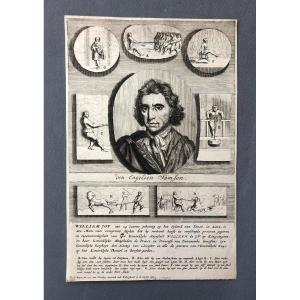- The wide margin with traces of pressing due to the impression, the sitter's left foot with a small purple stain, otherwise in vibrant condition.
- The Burden of the Prophet -
The large-format woodcut shows a prophet figure that takes up almost the entire height of the sheet. However, instead of seeing something in the distance that is still hidden from our eyes - as is usual in depictions of prophets - the figure has raised his hands in a defensive gesture, as if the prophet is trying to ward off what he has seen. At the same time, however, the position of the arms is an acceptance of the inevitable, which only those who recognize what is to come will have to bear for the time being, which is why the figure in the painting - despite its size - appears almost solitary, alone and exposed to the burden of suffering. In a manner reminiscent of the folds of medieval wooden sculptures, the expressive figure is "twitched" in a flash, illustrating the drama of the almost superhuman effort. The visible wooden structures of the background develop a vibrato that further energizes the depiction. Wilhelm Groß left the surface of the wood unpolished when he made the block, using the technique of frottage. The woodcut was printed by hand, so that the grain was rubbed through the paper. For Groß, the grown wood structure is an analogy for individuality, each broken in its own way. The prophet is a leitmotif in the work of Wilhelm Groß, for whom art itself has a prophetic character: "A beautiful work is [...] a work that appears with prophetic power.
About the artist
After deciding to abandon his career as a civil servant in favor of art, Wilhelm Groß went to Berlin in 1902, where he studied with the sculptors Otto Lessing and August Gaul. After beginning his studies at the Karlsruhe Art Academy, which he had to abandon for financial reasons, Groß returned to Berlin and worked as a freelance artist thanks to the support of his patron Eduard Arnhold. From 1904 until World War II, he enjoyed a fruitful artistic friendship with Max Beckmann. As a member of the Deutscher Künstlerbund (DKB), he won the Villa Romana Prize in 1908, which enabled him to stay in Florence, where he came into contact with Ernst Barlach and Max Klinger. The artist lived in Rome from 1909 to 1911. Called up for World War I, Groß was released from military service in 1915 for health reasons. His experiences in the war, though harrowing, were tantamount to a conversion, and from then on his art was inspired by his faith. His self-built studio in Oranienburg-Eden became a cultural meeting place and, as the "Strohkirche," a meeting place of the Confessing Church during the Nazi era, where Kurt Scharf and Martin Niemöller held services. In 1933, Groß was classified as "half Jewish," which resulted in a ban on exhibitions, expulsion from the Reich Chamber of Culture, and defamation of his works as "degenerate art. After the end of the Reign of Terror, Groß was ordained as a preacher in the province of Brandenburg and became pastor of the Sachsenhausen congregation. In 1953, he received an honorary doctorate from the Heidelberg Faculty of Theology. The artist responded to Walter Ulbricht's proclamation of the "Ten Commandments of Socialist Morals and Ethics" in 1961 with his last monumental sculpture, which depicts Moses with the Tablets of the Law.
"We should serve the great sculptor God as skilled tools. While working on a cross-bearing Christ in hard oak, I broke half of a valuable tool. Sadly, I put the stump aside and paid no attention to it for years, until one day I picked it up, removed the damaged piece of steel, and had the stump resharpened. Lo and behold, that short, unsightly iron became one of my favorite tools. The Lord works only with broken tools.”
- Wilhelm Gross
































 Le Magazine de PROANTIC
Le Magazine de PROANTIC TRÉSORS Magazine
TRÉSORS Magazine Rivista Artiquariato
Rivista Artiquariato